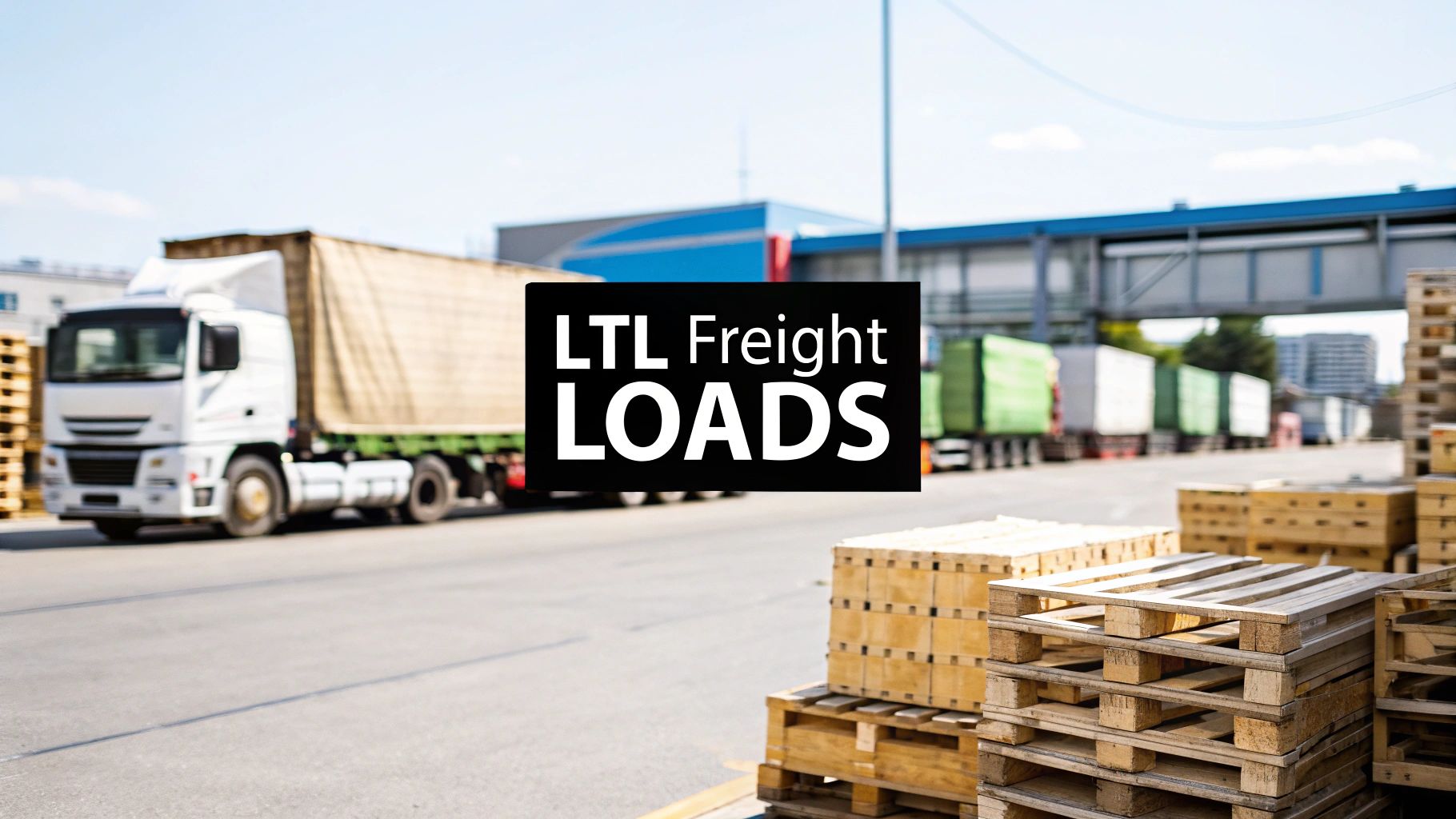
When your cargo is too big for standard parcel services but not quite enough to fill an entire truck, you've hit the shipping sweet spot. This is where LTL freight loads come in, offering a smart, cost-effective way to get your products where they need to go.
Think of it like a rideshare or a carpool, but for your freight. Instead of booking and paying for an entire vehicle yourself, you share the space—and the cost—with other shippers. It’s a practical solution that makes professional freight shipping accessible for everyone. Ready to see how affordable it can be? Get a free instant freight quote for your LTL or FTL shipment today.
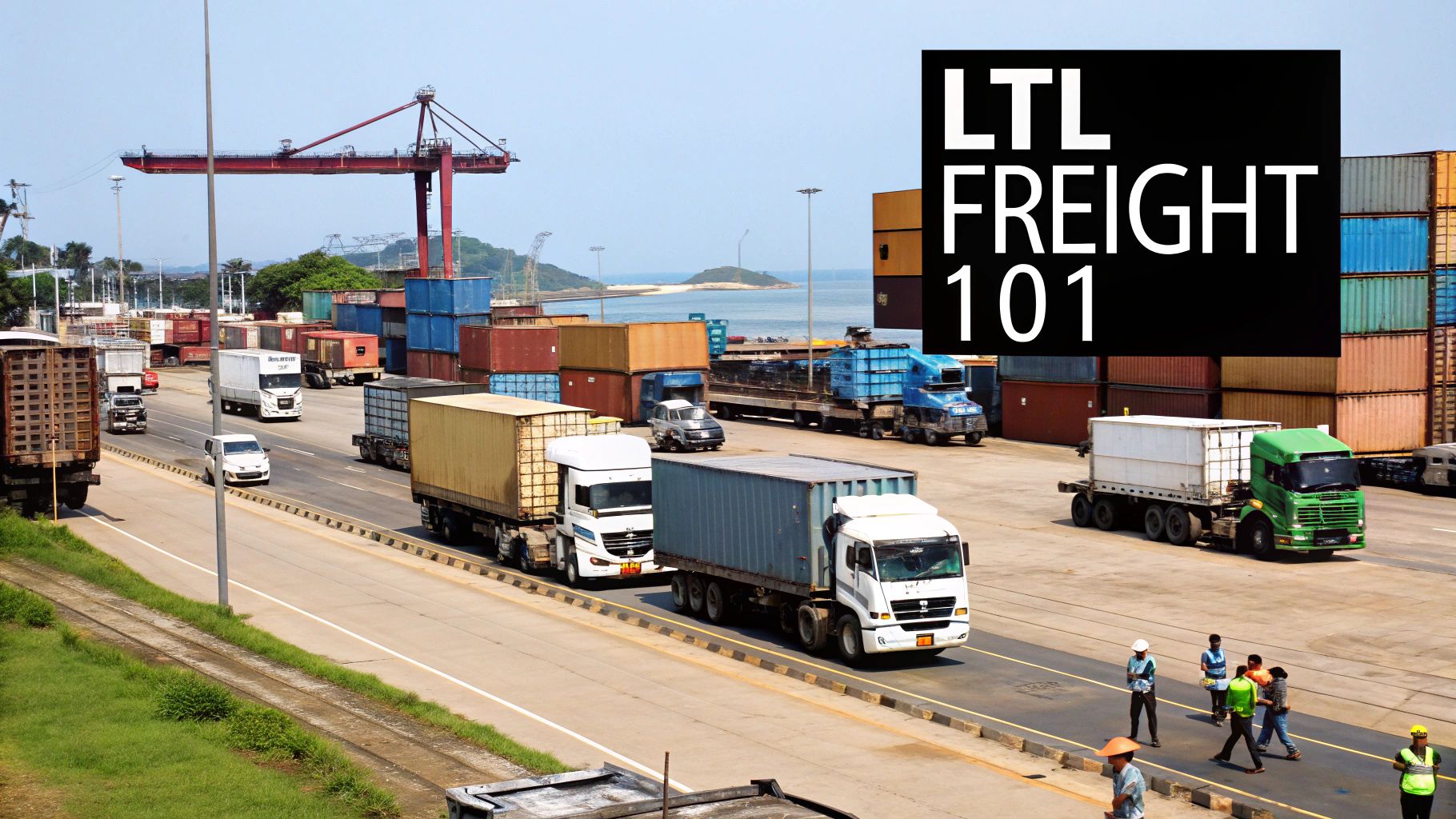
LTL, or Less-Than-Truckload, is a shipping method designed around efficiency. It works by combining smaller shipments from various businesses onto a single truck trailer. This way, the carrier can move a full truckload of goods, even if each individual shipment is relatively small.
So, how do you know if LTL is right for you? It's all about size and weight. If your shipment is somewhere between 150 and 15,000 pounds, or consists of one to six pallets, LTL is almost always the most logical choice. It perfectly bridges the gap between small package carriers (like UPS or FedEx) and Full Truckload (FTL) shipping, where you rent out an entire truck for your exclusive use.
The biggest difference between LTL and FTL really comes down to cost and exclusivity. When you book an FTL shipment, you’re paying a flat rate for the whole truck, whether it’s packed to the brim or half-empty. With LTL, you only pay for the specific space and weight your freight occupies.
By sharing truck space, companies can access professional freight services without the high expense of a dedicated vehicle. This makes LTL a fundamental tool for managing logistics costs effectively.
But there’s a trade-off, and it's all about timing. An FTL truck goes directly from Point A to Point B with only your cargo on board. It’s straightforward and predictable. An LTL shipment, on the other hand, is part of a network. The truck will make multiple stops to pick up and deliver other shipments along its route. This "hub and spoke" model means transit times can be longer and more variable.
This is a critical factor if you're on a tight deadline. Working with a knowledgeable partner can make all the difference in navigating these choices. Our guide on LTL freight brokerage explains how an expert can help you strike the perfect balance between cost and speed for your specific needs.
To make it even clearer, let's break down the three main shipping methods. This table gives you a quick snapshot to help you decide which service fits your shipment best.
Ultimately, choosing LTL is a strategic business decision that balances your budget, your shipment size, and your delivery timeline. It’s an incredibly valuable option that gives smaller shipments access to the same robust freight networks used by major distributors. Find out which method is right for your cargo and get a free instant quote for your LTL or FTL freight now.
Ever wondered how your one little pallet gets from Point A to Point B, riding along with goods from a dozen other companies? The whole process behind LTL freight loads is a bit like a well-choreographed dance, all built around a smart system that keeps costs down for everyone.
Think of it like booking a flight. If you need to get from a small town in Ohio to another small town in California, you don't hop on a private jet that flies direct. Instead, you'd probably fly from a local airport to a big hub like Chicago or Denver, then catch a connecting flight to your final destination. LTL shipping operates on that very same "hub-and-spoke" principle to juggle countless shipments efficiently.
Let’s trace the path of a single LTL shipment to see this system in action. From the moment it leaves your warehouse, your freight goes through several key steps designed to group it with other cargo and keep the truck as full as possible.
The journey breaks down into four main stages:
This image really helps visualize how the key factors of weight, distance, and any extra services you need all come together to create your final shipping rate.
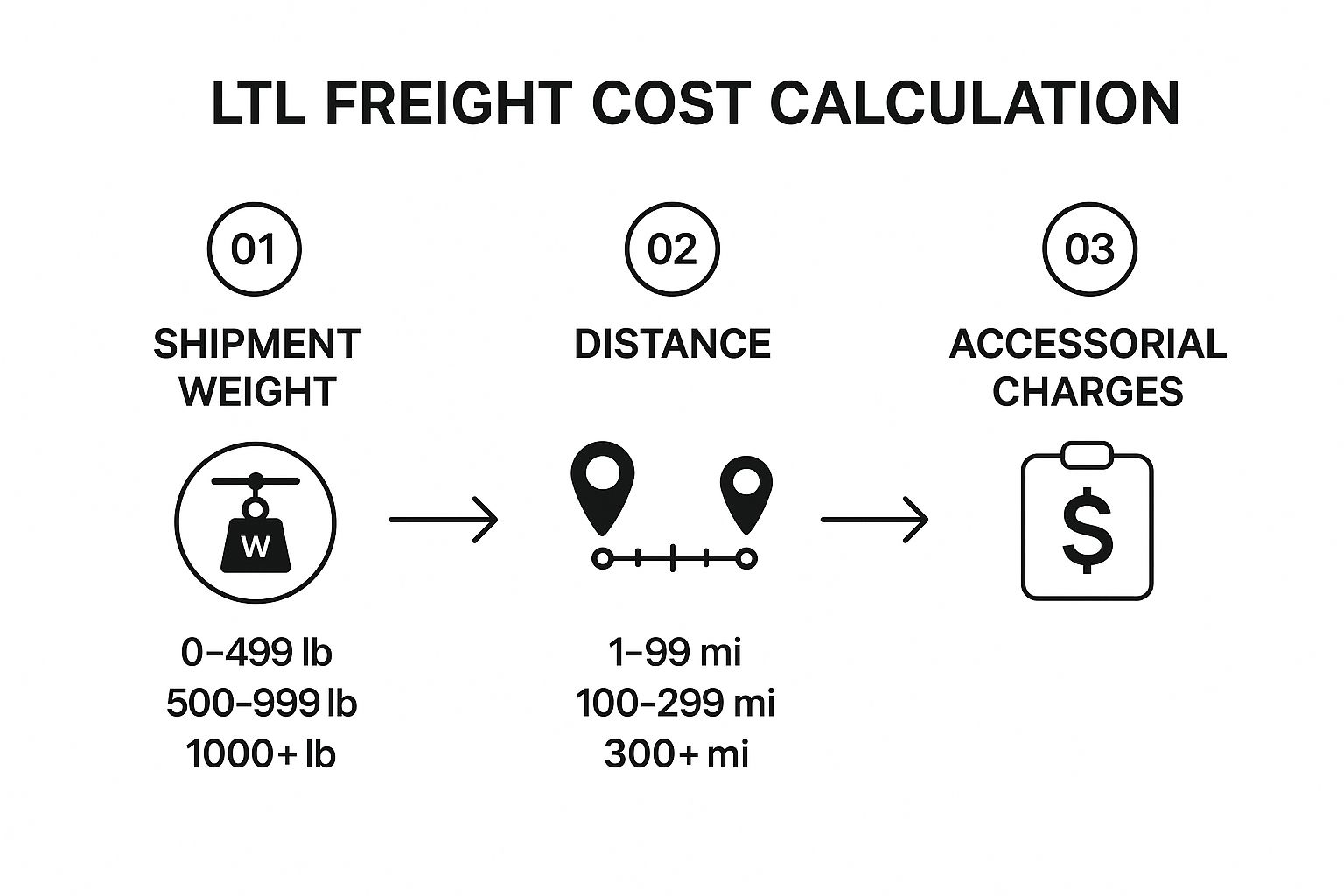
As you can see, a final LTL quote isn't just a simple calculation. It’s a blend of several crucial data points that carriers need to accurately price a shipment.
The hub-and-spoke model is the secret sauce that makes LTL so affordable. By combining freight from many shippers, carriers make sure their trucks are running as full as possible. This cuts down on wasted space and fuel, and those savings get passed directly on to you.
Of course, this efficiency does come with a trade-off. Your freight is handled multiple times—at the origin terminal, the destination hub, and during transfers. This means LTL transit times are naturally longer and a bit less predictable than a direct, dedicated Full Truckload (FTL) shipment. It's something to keep in mind if you're working with a razor-thin delivery deadline.
Ready to see how this system can work for your bottom line? You can easily compare rates from over 200 LTL specialists to find the perfect fit for your cargo. Get a free instant freight quote for your next shipment and see the savings for yourself.
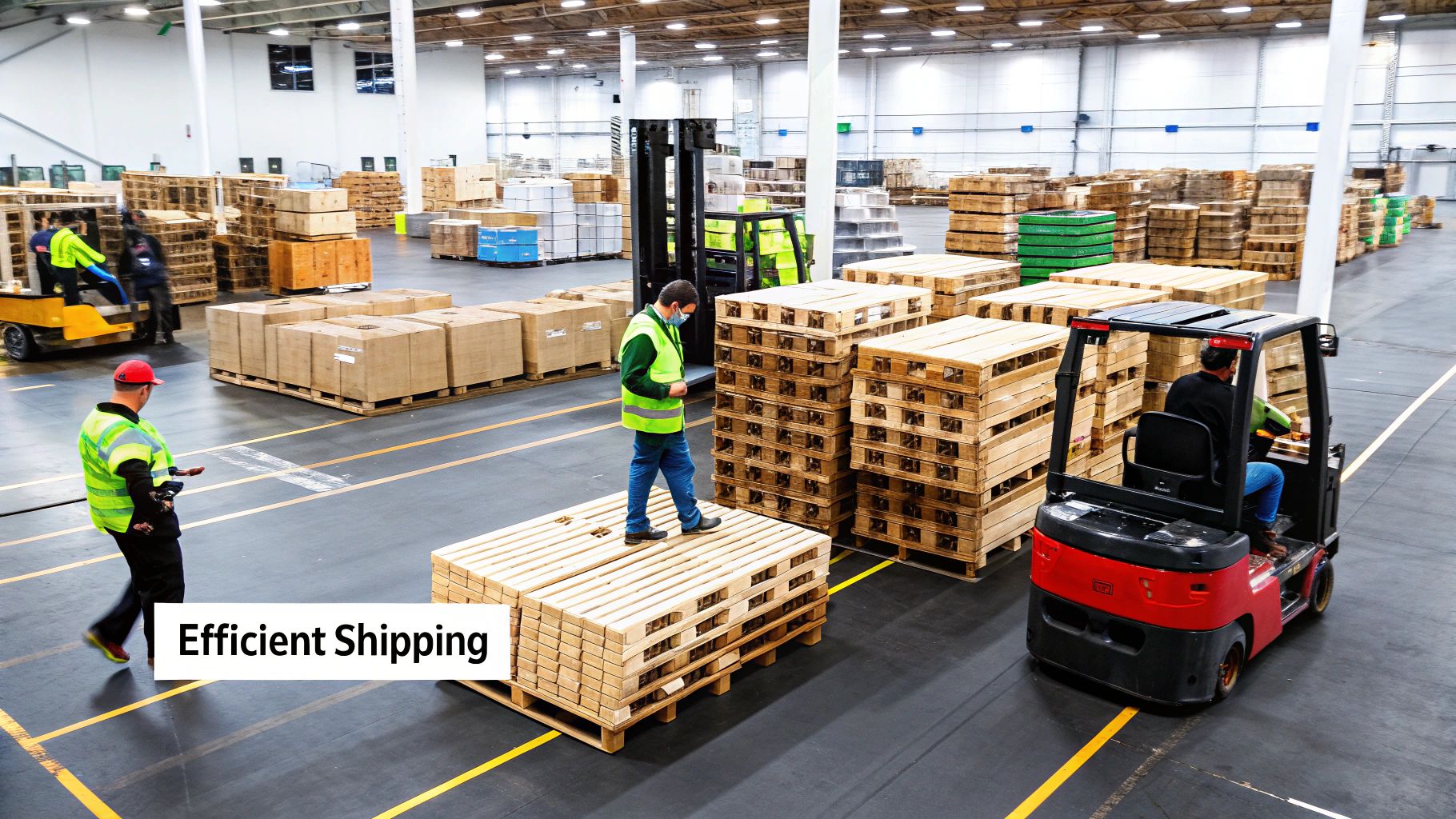
Let's talk about the big question: what’s this going to cost me? When it comes to LTL freight loads, the price isn't a simple flat fee. Think of it more like putting together a puzzle—your final bill is a sum of several interlocking pieces. Getting a handle on these elements is the first step to managing your budget and finding smart ways to save money.
The LTL world is booming. The market was valued at around USD 221.7 billion and is expected to climb to nearly USD 293.7 billion by 2030. This isn't just a random number; it shows how much businesses rely on LTL, especially with the growth of e-commerce. You can dive deeper into the research behind these global LTL market trends if you're curious.
So, what goes into that final number on your quote? Carriers look at a few core components to figure out the risk, space, and effort involved in moving your goods. These aren't just pulled out of thin air; they tie directly to the real-world costs of getting your freight from Point A to Point B.
Here are the main things that drive your shipping cost:
Think of freight class as a shipping "difficulty score." A low class (like 50) is for dense, durable items that are easy to handle. A high class (like 500) is for fragile, bulky things that take up a ton of space for their weight—like a pallet of ping-pong balls.
On top of the base rate, you might see accessorial fees on your invoice. These are simply charges for any services that go beyond the standard dock-to-dock pickup and delivery. Knowing about them ahead of time is the best way to avoid surprise charges.
Some of the most common accessorials are:
All these variables might seem like a lot to juggle, but you don't have to guess. The best way to see how it all adds up for your shipment is to compare real numbers. Get your free instant freight quote to see rates from different carriers and take control of your logistics budget.
Knowing the nuts and bolts of how LTL is priced and moved is helpful, but the real magic happens when you see what it can do for your business. The most immediate and obvious win with LTL freight loads is, without a doubt, the cost savings.
Think about it—why pay for an entire truck when you only need a small slice of it? With LTL, you're only on the hook for the space your pallets actually occupy. If your shipment takes up just 10% of the truck, you pay for that 10%. It’s that simple. This shared-space approach makes professional shipping genuinely affordable, especially for smaller businesses or companies managing fluctuating inventory. It's the go-to solution for anyone shipping between one and six pallets for exactly this reason.
While saving money is a huge plus, the advantages of LTL shipping go way beyond your budget. LTL offers a kind of flexibility that’s often tough to find with a full truckload. Since you aren't tied to filling a whole trailer, you can send out smaller shipments more often. This keeps your inventory lean and lets you react quickly to what your customers want.
On top of that, LTL carriers are pros at handling the extra services needed for final-mile deliveries. These "accessorial" services are often a lifesaver. They include things like:
These options make the whole process smoother for you and your customers, adding a layer of convenience that can make all the difference.
LTL shipping isn't just a budget-friendly option; it's a strategic tool. It provides the flexibility and specialized services that empower small and growing businesses to compete on a larger scale.
Finally, let's not forget the green angle. By combining shipments from multiple companies, LTL puts fewer half-empty trucks on the road. This smarter, consolidated model means better fuel efficiency and a smaller carbon footprint for every single pallet shipped. It’s a practical step toward building a more sustainable supply chain.
Curious to see these benefits in action? Find out just how much you could save on your next shipment. Get your free instant freight quote and compare competitive rates for both LTL and FTL freight in minutes.
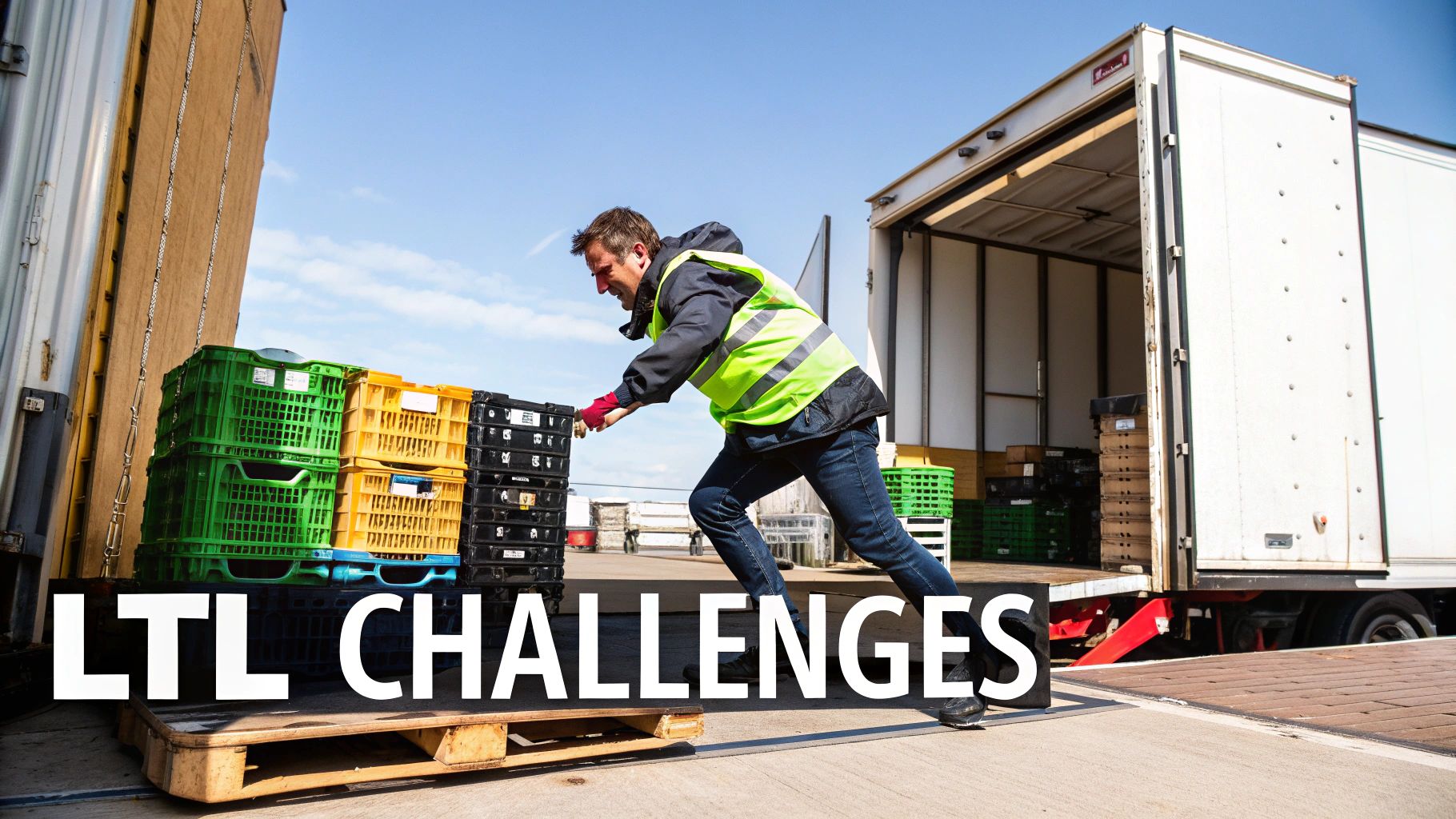
If you think of LTL shipping as an old-school, slow-moving part of the logistics world, it’s time to look again. The entire industry is getting a serious upgrade, and a huge part of that is thanks to the e-commerce boom.
Think about it: online retail is all about moving smaller quantities of products quickly and often. That’s the very definition of what LTL does best. This explosion in online shopping has put LTL front and center, with retailers depending on it to keep inventory flowing between warehouses and to get orders out to customers without the delay of filling a full truck.
This isn't just a small trend, either. The demand is so massive that the global LTL market is projected to expand by an incredible USD 110.7 billion between 2025 and 2029. You can dig deeper into the advances driving the LTL market to see just how much technology is fueling this growth.
But it’s more than just e-commerce. The tools of the trade are getting a whole lot smarter, making LTL faster and more reliable than ever.
Technology is truly the new engine running the LTL industry. Carriers and brokers aren’t just sticking to the old ways; they’re using sophisticated software to solve classic logistics headaches. For shippers like you, this means better service and more predictable pricing.
Here’s a look at how this tech is making a real difference:
LTL is no longer just a legacy shipping method. It’s a dynamic, tech-forward industry adapting to the demands of modern commerce, making it a strategic choice for businesses of all sizes.
These improvements are doing more than just adding convenience; they're creating efficiencies that help offset rising operational costs across the board. By embracing these tools, the LTL industry is becoming one of the most agile and responsive parts of the entire freight world.
Don't let your business fall behind. See how these modern logistics solutions can work for you by getting a free instant quote for your LTL or FTL freight today.
Knowing how LTL freight loads work is one thing, but actually using that knowledge to save money and avoid headaches? That's a whole different ball game. The good news is that shipping smarter, not harder, boils down to a few practical habits that can make a massive difference to your budget and efficiency. These aren't complicated industry secrets—just simple, actionable steps.
So many of the most common (and expensive) mistakes happen long before the truck even shows up. In fact, vague or just plain wrong information is the #1 reason for those surprise fees that nobody likes. If you focus on getting the details right from the very beginning, you can sidestep frustrating reweigh charges and damage claims, making sure everything goes smoothly from your dock to its destination.
Your path to better shipping starts with two things: precise details and solid packaging. Nailing these elements is absolutely non-negotiable if you want to keep costs under control.
Provide Dead-On Accurate Dimensions and Weight: This is the golden rule of LTL. Carriers rely on this info to plan out every inch of their truck space and figure out your rate. If you say a pallet is 500 lbs but it tips the scales at 750 lbs, you're guaranteed to get hit with a reweigh fee and a much higher bill. Always, always measure and weigh your freight after it’s been fully packaged, crated, or palletized.
Package and Palletize Like a Pro: Don't let your valuable products get banged up on the road. You need to securely stack your boxes on a sturdy pallet and then use plenty of shrink wrap to make it one solid, stable unit. This does more than just protect your goods through the multiple stops of an LTL journey; it helps you avoid the hassle and profit loss of filing damage claims.
Think of a correctly filled-out Bill of Lading (BOL) as your shipment's passport. It holds all the vital information—addresses, weight, freight class, and what's actually in the boxes. An inaccurate BOL is a recipe for delays, billing errors, and sometimes, even lost freight.
Once your freight is packed and ready to roll, a little bit of planning can unlock some serious savings. In the world of LTL, flexibility is your best friend.
If you aren't in a huge rush, you can often find much better rates. When you give carriers a wider delivery window, they can fit your shipment into their schedule more easily, and they'll often pass those operational savings right on to you. Also, keep an eye out for chances to consolidate. Can you combine a few small orders heading to the same area into one larger LTL shipment? Sending one 1,200 lb shipment is almost always going to be cheaper than sending three separate 400 lb shipments.
But here’s the most powerful tip of all: stop guessing. Instead of spending hours calling individual carriers one by one, use a freight platform to instantly compare rates from multiple companies side-by-side. This is the only way to be sure you aren’t just getting a decent price—you’re getting the best one available for your specific shipment.
Ready to put these tips into practice? Get your free instant freight quote for your FTL or LTL shipment and see the savings for yourself.
Even after you get the hang of the basics, LTL shipping can throw a few curveballs. It’s totally normal to have questions pop up, so let's tackle some of the most common ones.
Think of this as your quick-reference guide to clear up any lingering confusion before you lock in your next shipment.
A freight class is a number between 50 and 500 that helps carriers standardize pricing. You can think of it as a "shipping difficulty score." It boils down to four things: how dense your item is, how easy it is to stow, how much special handling it needs, and its liability (how fragile or valuable it is).
For example, a dense, durable pallet of engine parts is easy to ship, so it gets a low class like 55. On the other hand, a bulky but fragile pallet of fancy light fixtures? That’s much trickier to handle and gets a high class, like 250. Getting this number right is absolutely crucial for an accurate quote. The easiest way to find it is with a freight class calculator or by simply asking a freight broker to figure it out for you.
This is where LTL differs big time from a dedicated truckload (FTL). LTL transit times are always estimates. Because your freight is on a truck that's making multiple stops for other pickups and deliveries, a shipment can take anywhere from 2 to 10 business days. It all depends on the distance and the specific shipping route.
A good rule of thumb is to mentally add an extra day to your timeline for every major terminal your freight has to pass through. When it comes to LTL, a little flexibility goes a long way.
You can definitely go directly to a carrier, but working with a freight broker or a platform like ours usually makes a lot more sense. A good broker has established relationships with hundreds of carriers, which means they can get you the best possible rate in seconds—a task that could take you hours of phone calls and web searches.
Beyond just finding a good price, they handle all the paperwork, track your shipment from start to finish, and become your single point of contact if anything goes sideways. For most businesses, this ends up saving a ton of time and money, making it a much smarter way to manage your LTL freight.
Ready to stop guessing and start shipping smarter? The team at FreightQuotesNow is here to answer any other questions you have. See how easy logistics can be and get your free instant quote for any FTL or LTL freight you need. Get a free instant freight quote.
Article created using Outrank